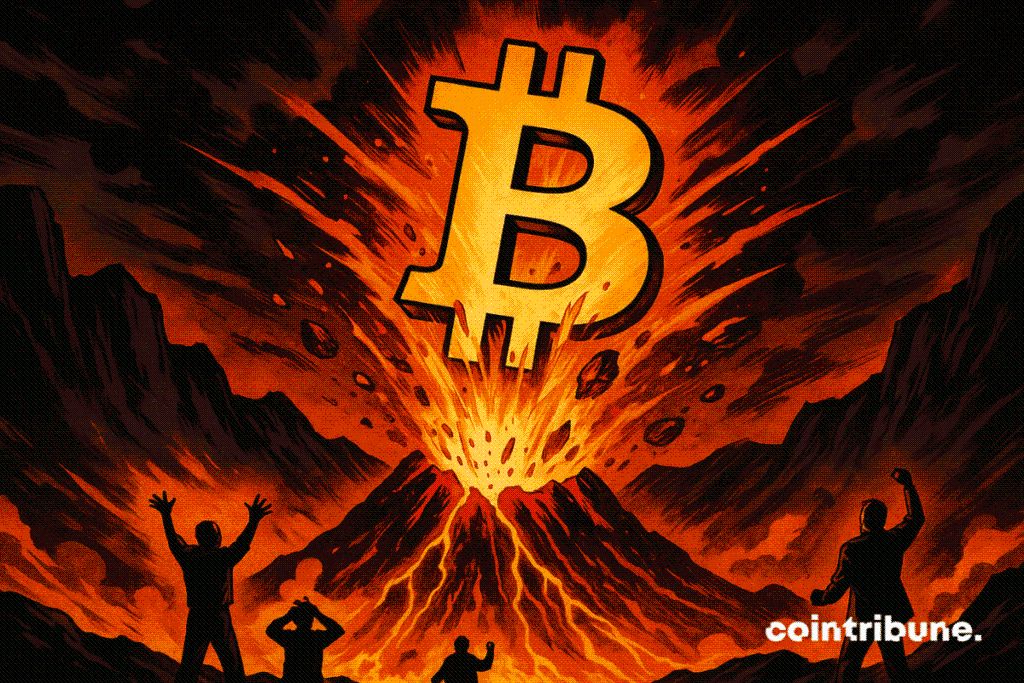Bitcoin Reaches Record High In Turbulent Markets
As monetary benchmarks collapse, bitcoin establishes itself as the flagship asset of a new financial order. Surpassing $125,700, it reaches an unprecedented peak and propels its capitalization beyond $2.5 trillion. This rapid ascent occurs amid political tensions in the United States and dollar fragility, reshaping the power lines of global markets. This symbolic threshold signals a profound shift of confidence towards a decentralized alternative.

In Brief
- Bitcoin reaches a new historic high of over $125,700, with a record capitalization exceeding $2.5 trillion.
- This surge occurs within a context of rapid depreciation of the US dollar, on track to experience its worst year since 1973.
- Falling interest rates in the United States and a weakening job market increase the flight of capital towards alternative assets.
- On-chain data show an accumulation phase driven by large holders, with a clear decline in selling pressure.
The Dollar’s Fall and a Crisis of Confidence : The Macroeconomic Foundation of Bitcoin’s Rally
In a context of increasing monetary tensions, bitcoin soared to $125,700 , driven by an exceptional convergence of economic factors unfavorable to the dollar.
According to analysts from the Kobeissi Letter, “the dollar is on track to suffer its worst year since 1973,” with a drop of more than 10 % since the beginning of the year. This sharp decline fits into a long-term trend: the greenback has lost 40 % of its purchasing power since 2000, they recall.
Meanwhile, other assets considered as stores of value, such as gold, also reach record levels, $3,880 per ounce, nearing $4,000, while the S&P 500 rises more than 40 % over six months.
The signals sent by the markets indicate a profound change in economic expectations, summarized by Kobeissi Letter : “markets now factor in a new monetary policy.” This reconfiguration rests on several concrete elements :
- The weakening of the dollar : a drop of more than 10 %, the worst annual performance in several years ;
- The Fed’s change of course : with inflation rebounding and a pressured labor market, the Federal Reserve has initiated rate cuts ;
- A flight to tangible assets : bitcoin, gold, stocks all rise simultaneously, breaking usual historical correlations ;
- An unprecedented correlation : the coefficient between gold and the S&P 500 has reached 0.91, a sign that investors are reassessing their safe haven criteria ;
- Loss of monetary confidence : the structural depreciation of the dollar rekindles appeal for non-sovereign assets like bitcoin.
In short, BTC’s spectacular rise cannot be understood without considering the destabilization of the Western monetary paradigm.
An Accumulation Phase and Institutional Signals
Beyond the global macroeconomic context, the bitcoin market shows clear signs of structural recovery, notably an accumulation phase driven by long-term investors.
According to Fabian Dori, Chief Investment Officer at Sygnum Bank, on-chain data indicate that selling pressure from long-term holders appears to be easing, while short-term investors stabilize after a period of realized losses.
This trend suggests the market is consolidating at high levels, and the excessive speculation that characterized some previous phases of the cycle is diminishing. Additionally, the open interest on derivatives fell sharply following the recent expiration of BTC options, which could lay the groundwork for a new bullish impulse in the fourth quarter.
Other analysts go further in their projections. At the Token2049 summit, Charles Edwards stated that if bitcoin maintains its momentum above $120,000, a scenario of rising to $150,000 by the end of the year remains possible.
This forecast relies on technical indicators but also on a climate of reduced available supply against increasing institutional demand. However, some observers like Jake Kennis (Nansen) urge caution : “it is premature to call a local bottom. Stability for several weeks above key levels will be needed to confirm it.” Thus, this tempered skepticism shows that despite the euphoria, part of the market remains attentive to the strength of the current support.
These dynamics reveal a potentially decisive last quarter for bitcoin’s evolution. If institutional enthusiasm continues and macro conditions keep deteriorating for the dollar , the trajectory towards new highs could accelerate. Conversely, a return to economic stability or a less accommodative monetary policy could slow this momentum.
Disclaimer: The content of this article solely reflects the author's opinion and does not represent the platform in any capacity. This article is not intended to serve as a reference for making investment decisions.
You may also like
Bitcoin Updates: Chicago Bitcoin ATM Sales—Expansion Plan or Result of DOJ Actions?
- Chicago-based Bitcoin ATM operator Crypto Dispensers explores a $100M sale amid federal money laundering charges against founder Firas Isa. - DOJ alleges the company processed $10M in illicit funds via ATMs, converting cash to crypto through untraceable wallets despite KYC obligations. - The firm shifts to software operations since 2020, citing rising compliance costs and fraud risks amid broader crypto market turbulence. - Isa faces up to 20 years in prison if convicted, while DOJ’s enforcement signals

Zcash News Today: Zcash's Rise in Privacy Poses a Challenge to Bitcoin's Reign of Transparency
- Zcash (ZEC) surged 150% in 30 days, outperforming crypto markets amid Cypherpunk's $18M ZEC investment boosting its $150M holdings. - Institutional demand for privacy coins like ZEC, Monero, and Dash grows as Zcash's 1.43% supply control tightens liquidity and drives $670+ prices. - Technical analysts project 40%+ gains if ZEC breaks $690, with Arthur Hayes predicting $1,000 potential, contrasting Bitcoin's $88k slump. - Zcash's November 2025 halving and privacy-focused narrative challenge Bitcoin's tran

YFI Declines 49.94% Over the Past Year as Overall Market Faces Downturn
- YFI fell 0.15% in 24 hours to $4006, with 49.94% annual decline amid broader crypto market downturn. - Yearn.finance lacks project updates or governance changes to drive price recovery since November 2025. - Token remains vulnerable to macroeconomic shifts and geopolitical risks affecting risk-on/risk-off investor behavior. - Analysts expect continued consolidation until on-chain metrics show ecosystem improvements or external market confidence rebounds.

Bessent: Raising the Debt Ceiling by July Is Essential to Prevent Market Turmoil
- US Treasury Secretary Bessent reiterated the economy is not at recession risk despite fiscal debates and market volatility. - He warned the debt ceiling must rise by July 2025 to avoid default, stressing "full faith and credit" is non-negotiable. - Corporate resilience (e.g., Ross Stores' strong earnings) contrasts with Fed policymakers' split on rate cuts amid inflation concerns. - Trump's $2,000 "tariff dividend" proposal faces congressional hurdles, with Bessent acknowledging it requires legislative a

